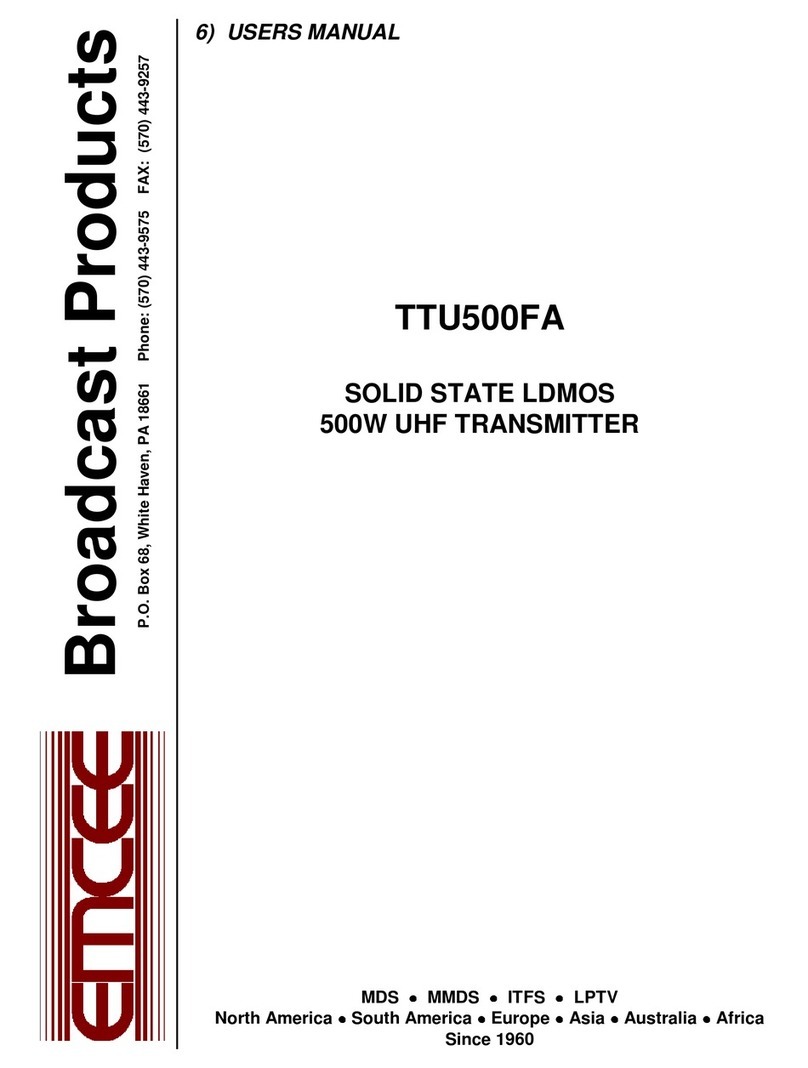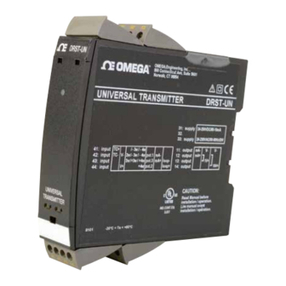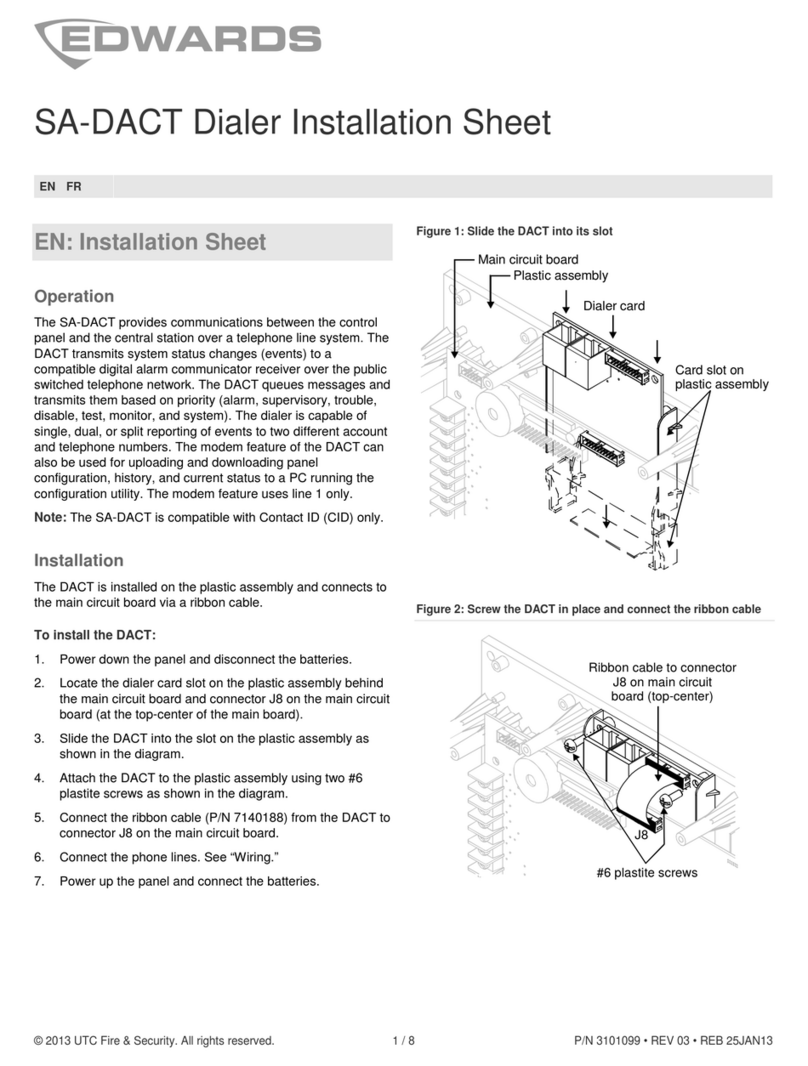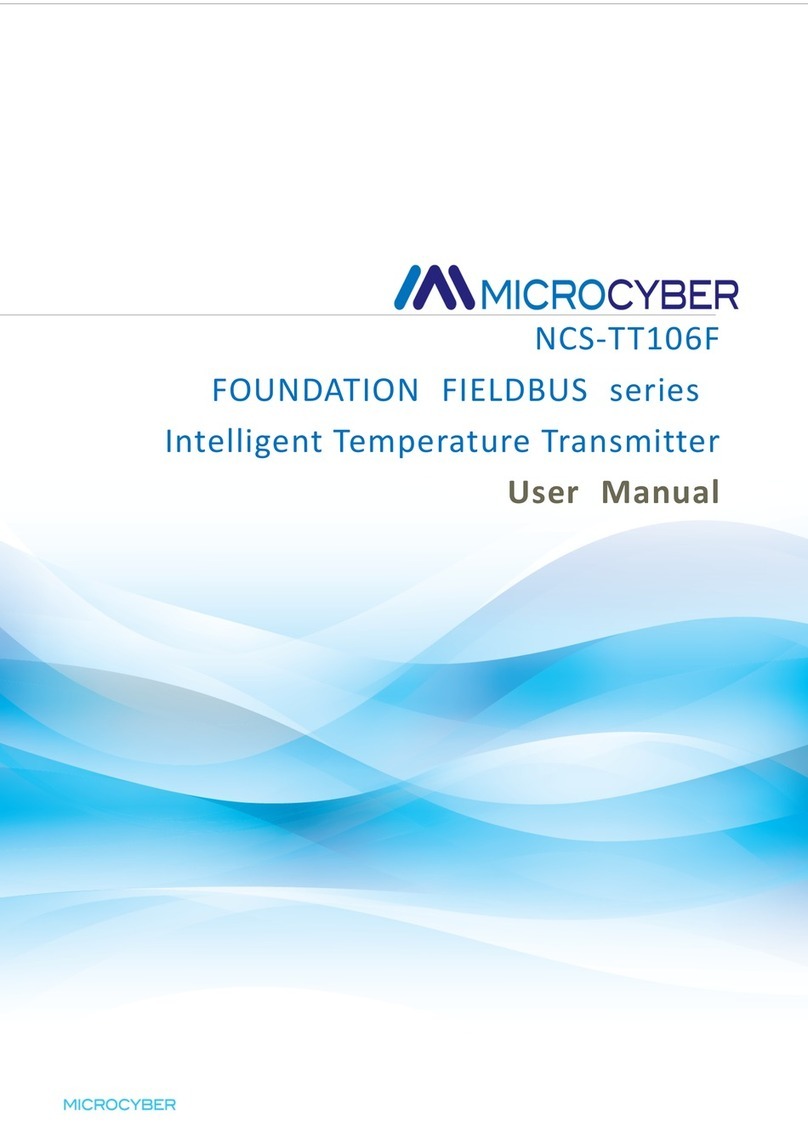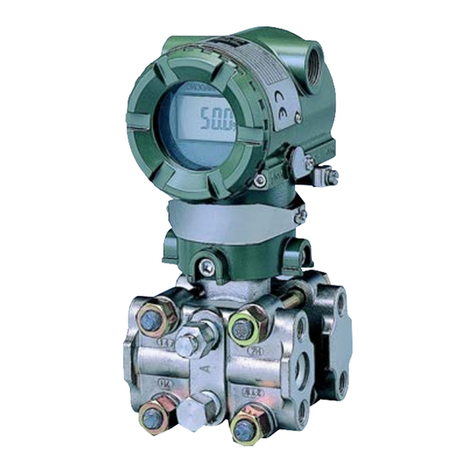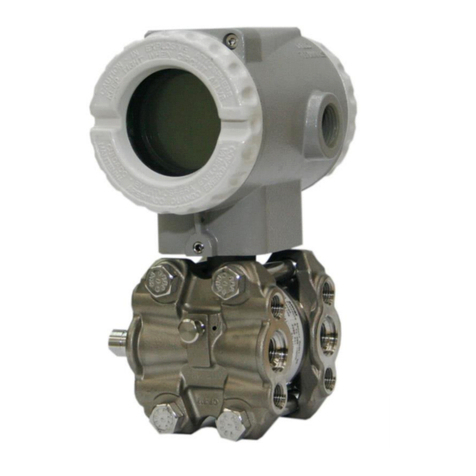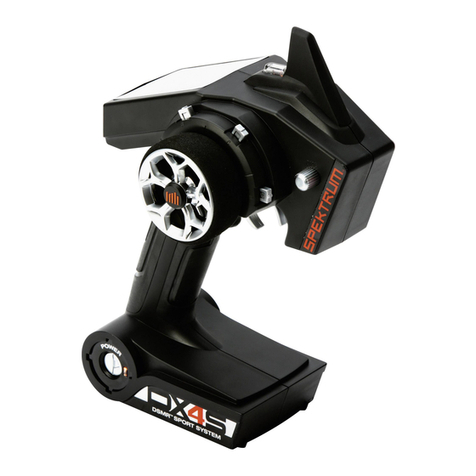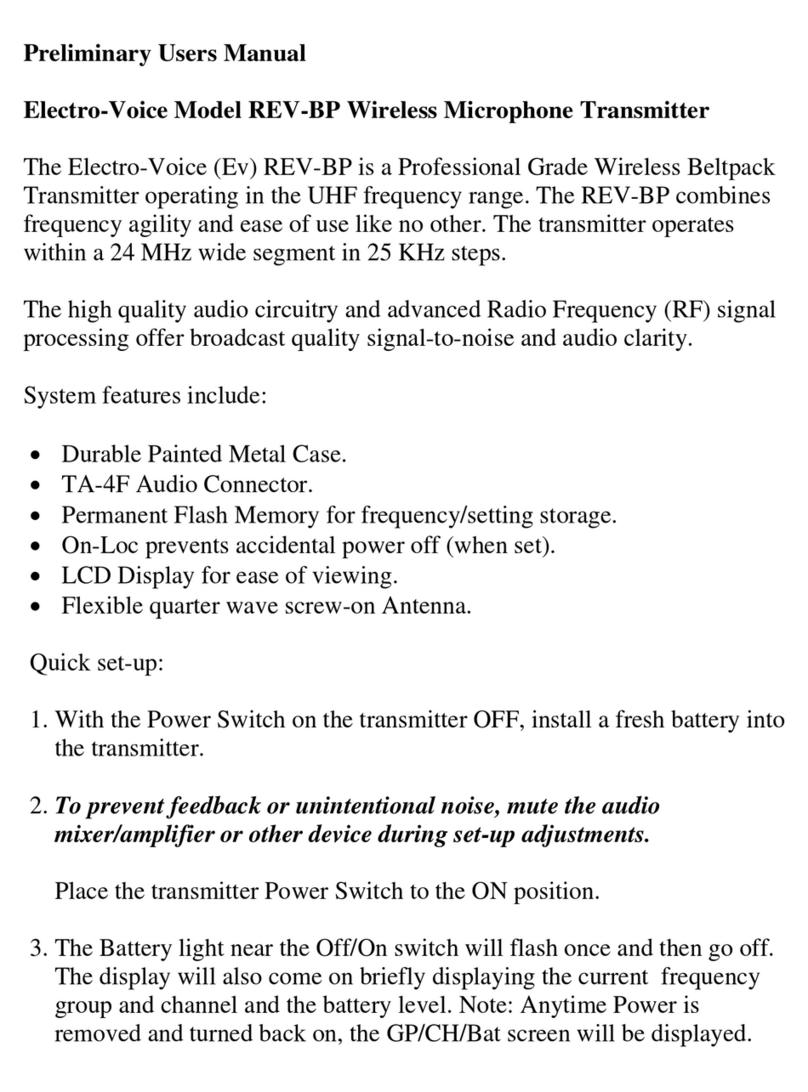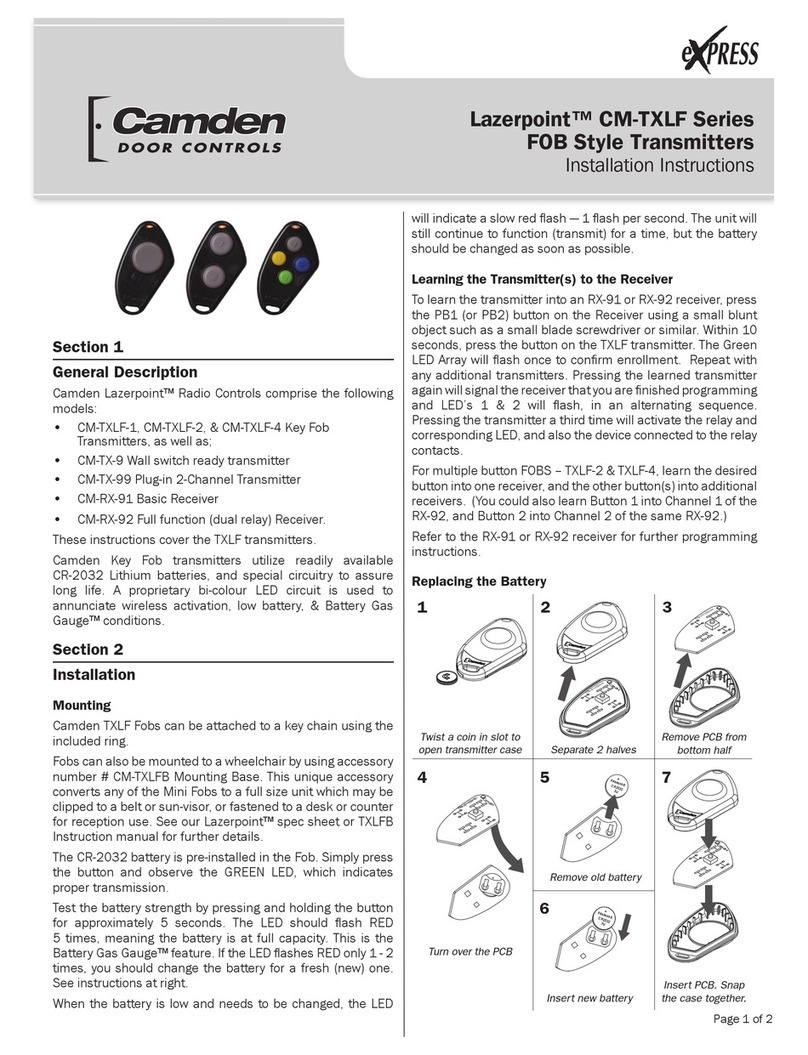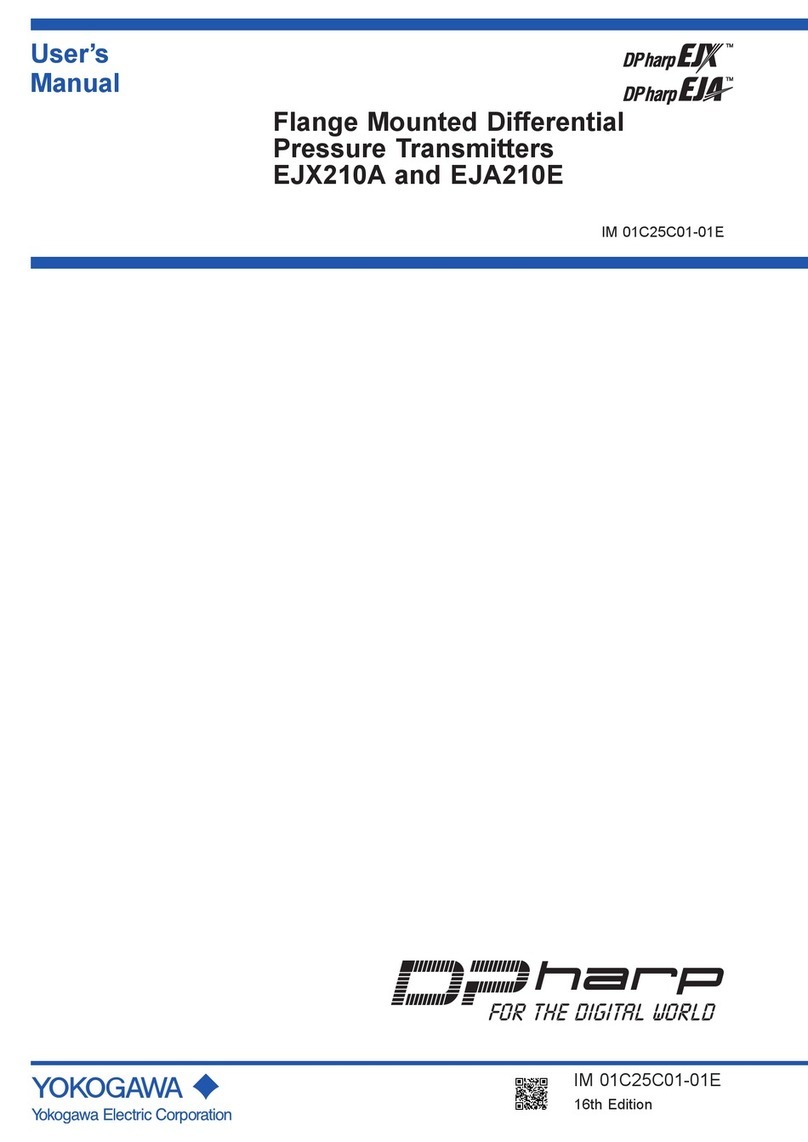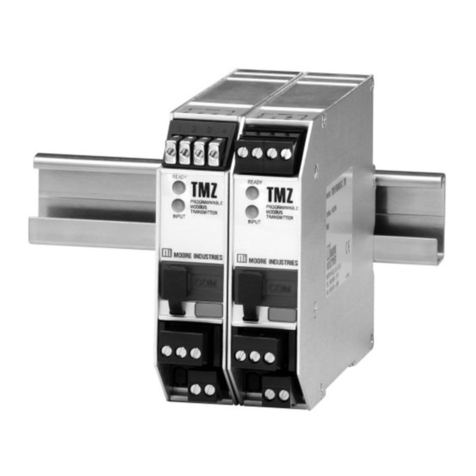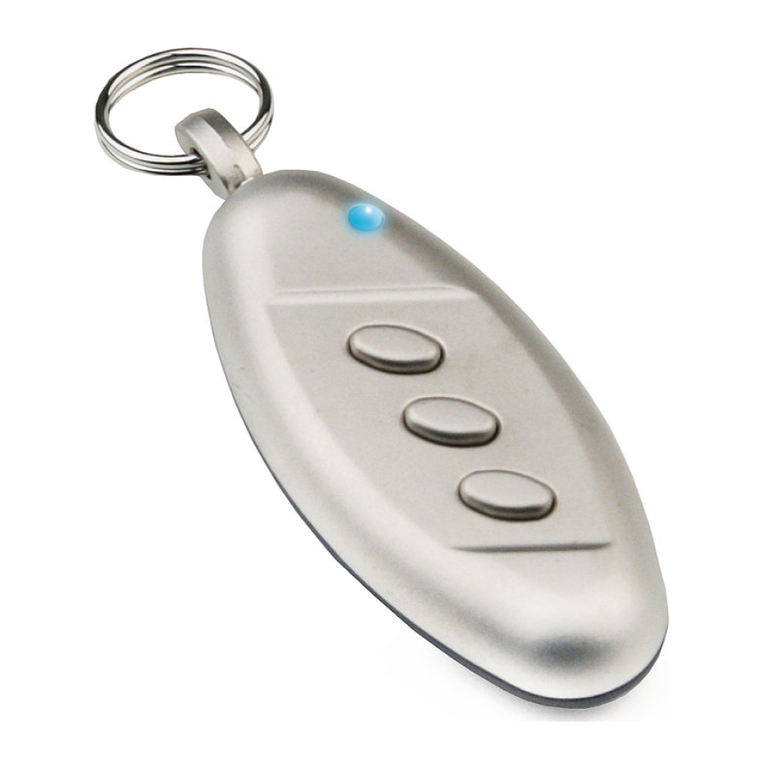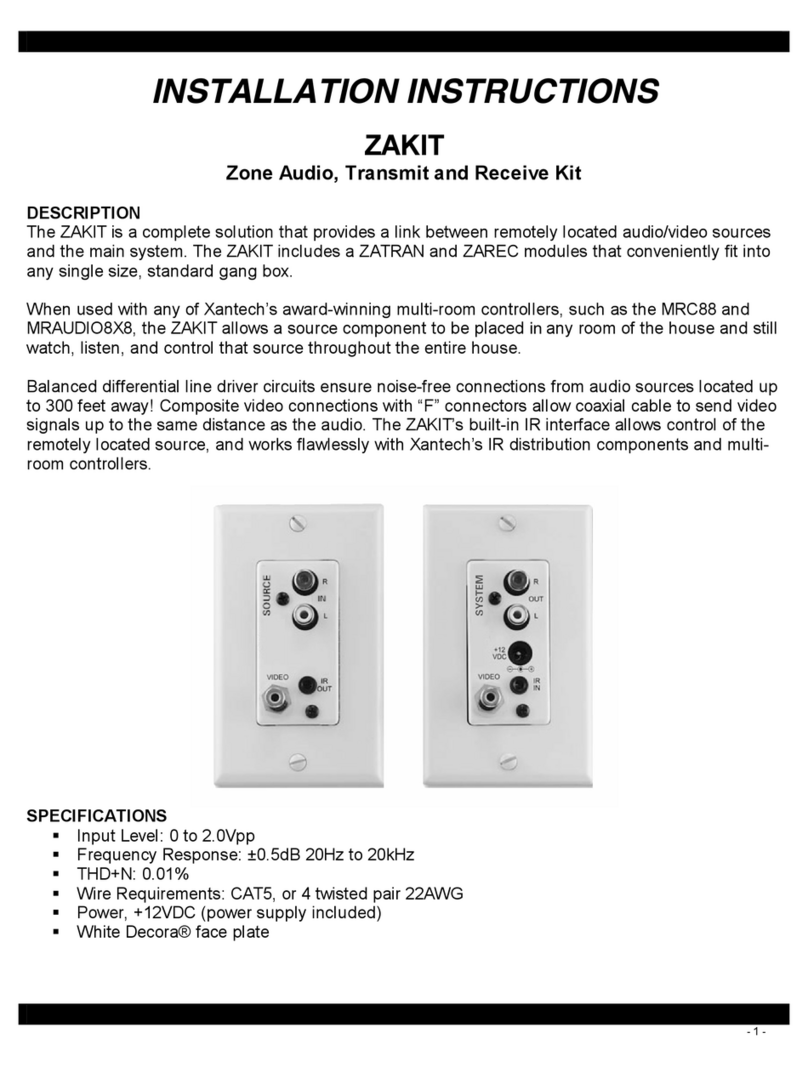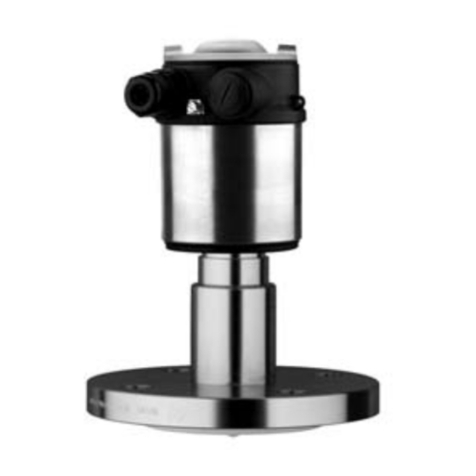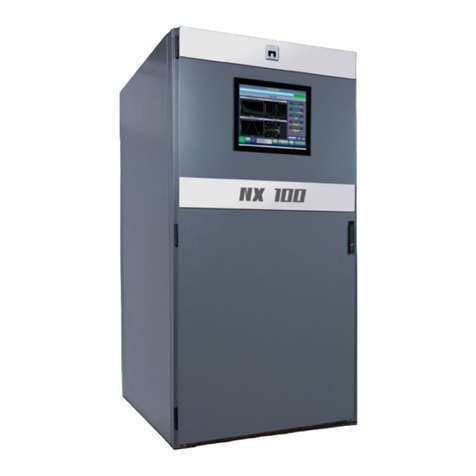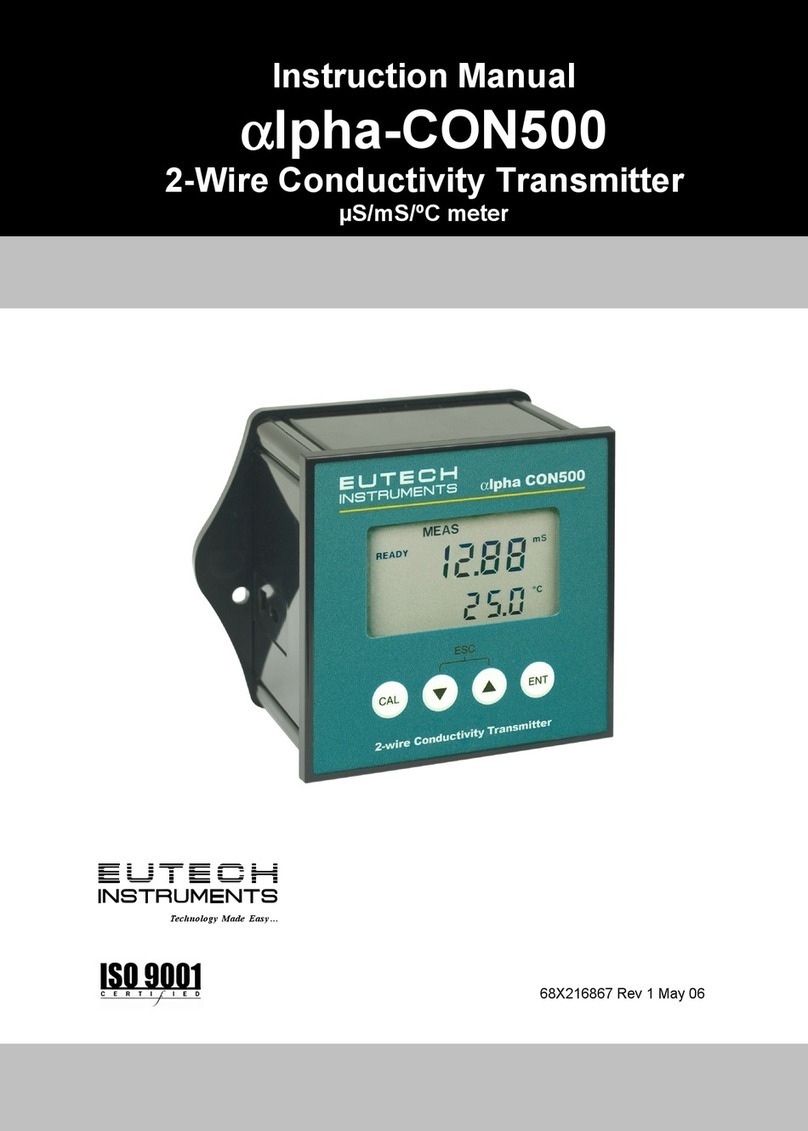Emcee HSD Series Instruction Manual

HSD SeriesTM
Transmitters
HSD-2500
OPERATION AND
MAINTENANCE
GUIDE
Release 1.0
®
COMMUNICATIONS
Mountain Top, PA, USA

RELEASED: 10/2/2006
Page 2
COMMUNICATI0NS HSD SERIES OPERATION AND MAINTENANCE
This is an unpublished work protected by the United States copyright laws and is proprietary to EMCEE Communications.
Disclosure, copying, reproduction, merger, translation, modification, enhancement or use by anyone other than authorized
employees or licensees of EMCEE Communications without the prior written consent of EMCEE Communications is strictly
prohibited.
Copyright © 2006 EMCEE Communications. All rights reserved.
This copyright notice should not be construed as evidence of publication.
TABLE OF CONTENTS
1 THE HSD SERIES TRANSMITTER 0VERVIEW .......................................................5
1.1 Introduction: .................................................................................................5
1.2 Safety Warnings and Precautions:.................................................................6
1.2.1 Safety Considerations: ............................................................................6
1.2.2 Safety with Electricity: ............................................................................6
1.2.3 Preventing Electrostatic Discharge Damage: ..........................................7
1.2.4 Emission Notice: .....................................................................................7
1.3 HSD-2500 Design Specifications: ..................................................................9
1.4 Installation: .................................................................................................11
1.5 Operation:...................................................................................................12
1.6 Controls and Indicators:..............................................................................13
1.6.1 Front Panel Controls-Pictorial View: ......................................................14
1.7 List of Interconnecting Diagrams:................................................................14
1.8 List of Schematic Diagrams:........................................................................14
1.9 Warranty and Parts Ordering: .....................................................................14
2 MECHANIAL LEVEL OVERVIEW ........................................................................17
2.1 TRANSMITTER DIS-ASSEMBLY & MODULE LOCATION: ..............................17
2.1.1 INTERNAL VIEW-Up-Converter Drawer: ................................................19
2.1.2 REAR VIEW-Main Chassis:.....................................................................20
2.1.3 INTERNAL VIEW-Main Chassis: .............................................................21
3 CIRCUIT DESCRIPTIONS...................................................................................22
3.1 UP-CONVERTER DRAWER: .........................................................................22
3.1.1 Up-Converter Block Diagram: ...............................................................23
3.2 1st IF Module:...............................................................................................23
3.3 1st Converter Module: ..................................................................................26
3.4 Output Converter Module: ...........................................................................27
3.5 10 MHz Reference Oscillator Module: ..........................................................29
3.6 Control Board: ............................................................................................31
3.7 Display Board: ............................................................................................34
3.8 Driver Amplifier Module:..............................................................................36
3.9 Remote Control/Status Board:.....................................................................37
3.10 Up-Converter Power Supply: .....................................................................37
3.11 Main Chassis:............................................................................................38
3.11.1 Main Chassis Block Diagram ...............................................................38
3.12 +12 Volt Power Supply System ..................................................................39
3.13 Power Divider Module ...............................................................................39
3.14 12.5 WATT AMPLIFIER: .............................................................................40
3.15 Amplifier Combiner Module: ......................................................................41
3.16 Metering Coupler: .....................................................................................42
3.17 Metering Detector: ....................................................................................42
4 REMOTE STATUS/CONTROL SOFTWARE..........................................................44
5 MAINTENANCE .................................................................................................45
5.1 Periodic Maintenance Schedule: .................................................................45

RELEASED: 10/2/2006
Page 3
COMMUNICATI0NS HSD SERIES OPERATION AND MAINTENANCE
This is an unpublished work protected by the United States copyright laws and is proprietary to EMCEE Communications.
Disclosure, copying, reproduction, merger, translation, modification, enhancement or use by anyone other than authorized
employees or licensees of EMCEE Communications without the prior written consent of EMCEE Communications is strictly
prohibited.
Copyright © 2006 EMCEE Communications. All rights reserved.
This copyright notice should not be construed as evidence of publication.
5.2 Recommended Test Equipment:..................................................................45
5.3 Troubleshooting:.........................................................................................46
5.4 Front Panel Indicators:................................................................................46
5.5 HSD-2500 TROUBLESHOOTING CHART......................................................47
5.6 Output Power Calibration: ...........................................................................49
5.6.1 Forward Power Calibration: ..................................................................50
5.6.2 Reflected Power Calibration:.................................................................51
5.7 Pre-Corrector Adjustment:..........................................................................52
5.8 FREQUENCY PROGRAMMING: ....................................................................53
5.8.1 ITFS/MMDS Channel Programming: .......................................................54
5.8.2 EBS/BRS Channel Programming: ..........................................................55
5.9 Interpreting Amplifier Fault Indications: ......................................................56
5.10 Calibrating Voltage Indications:.................................................................57
6 PARTS LISTS ....................................................................................................58
7 SCHEMATIC DIAGRAMS....................................................................................73
8 OPERATING MANUAL RELEASE NOTES ...........................................................95
TABLE OF FIGURES
Figure 1: Up-Converter Interconnection Diagram ................................................74
Figure 2: Transmitter Interconnect Diagram........................................................75
Figure 3: 1st IF, Schematic Diagram ....................................................................76
Figure 4: 1st IF, Component Layout .....................................................................77
Figure 5: Output Converter, Schematic Diagram .................................................78
Figure 6: Output Converter, Component Layout...................................................79
Figure 7: Driver Amplifier, Schematic Diagram ....................................................80
Figure 8: Driver Amplifier, Component Layout .....................................................81
Figure 9: 10 MHz Reference, Schematic Diagram ................................................82
Figure 10: 10 MHz Reference, Component Layout................................................83
Figure 11: First Converter, Schematic Diagram ...................................................84
Figure 12: First Converter, Component Layout ....................................................85
Figure 13: Display Board, Schematic Diagram.....................................................86
Figure 14: Display Board, Component Layout ......................................................87
Figure 15: Control Board, Schematic Diagram.....................................................88
Figure 16: Control Board, Component Layout ......................................................89
Figure 17: 12.5 Watt Amplifier, Schematic Diagram .............................................90
Figure 18: 12.5 Watt Amplifier, Component Layout ..............................................91
Figure 19: Metering Detector, Schematic Diagram ..............................................92
Figure 20: Metering Detector, Component Layout................................................93

RELEASED: 10/2/2006
Page 4
COMMUNICATI0NS HSD SERIES OPERATION AND MAINTENANCE
This is an unpublished work protected by the United States copyright laws and is proprietary to EMCEE Communications.
Disclosure, copying, reproduction, merger, translation, modification, enhancement or use by anyone other than authorized
employees or licensees of EMCEE Communications without the prior written consent of EMCEE Communications is strictly
prohibited.
Copyright © 2006 EMCEE Communications. All rights reserved.
This copyright notice should not be construed as evidence of publication.
TABLE OF TABLES
Table 1: 1st IF Board Parts List............................................................................59
Table 2: Output Converter Parts List ...................................................................61
Table 3: Driver Amplifier Parts List ......................................................................63
Table 4: 10 MHz Reference Module Parts List ......................................................64
Table 5: 1st Converter Module Parts List .............................................................66
Table 6: Display Board Parts List.........................................................................68
Table 7: Control Board Parts List.........................................................................69
Table 8: 12.5 Watt Amplifier Parts List .................................................................70
Table 9: Metering Detector Parts List ..................................................................72
1

RELEASED: 10/2/2006
Page 5
COMMUNICATI0NS HSD SERIES OPERATION AND MAINTENANCE
This is an unpublished work protected by the United States copyright laws and is proprietary to EMCEE Communications.
Disclosure, copying, reproduction, merger, translation, modification, enhancement or use by anyone other than authorized
employees or licensees of EMCEE Communications without the prior written consent of EMCEE Communications is strictly
prohibited.
Copyright © 2006 EMCEE Communications. All rights reserved.
This copyright notice should not be construed as evidence of publication.
1THE HSD SERIES TRANSMITTER 0VERVIEW
1.1 Introduction:
The EMCEE HSD SeriesTM transmitter is a modular, frequency agile, format agile, self-
contained S-Band broadcast transmitter that is designed to provide up to 400 Watts peak
power or 100 Watts average power on any FCC or CCIR specified channel from 2500MHz
to 2700MHz. The transmitter will accept either a digital input or a composite analog input.
The transmitter is also available configured for multi-channel operation. To provide
maximum performance and reliability, the HSD SeriesTM Transmitter is completely solid-
state. The transmitter design includes IF linearity pre-correction, which minimizes the in-
channel intermodulation products; oscillator and converter circuits optimized for very low
phase and FM noise, which allows for depth of modulation up to 256QAM; automatic
internal or external synthesizer lock, for use with phase-locked systems; and infinite tuning,
by 1 MHz steps, across the entire band. The transmitter is designed to provide
configurable and upgradeable output power, requiring only a 6RU rack footprint. It features
minimum weight and low power consumption; and employs comprehensive indication,
control, and protection circuitry. To provide additional reliability, the HSD SeriesTM
transmitter system is designed to utilize a redundant N+1 power supply and power
distribution system (HSDPLUS). The transmitter will facilitate either digital or analog
transmission, and is compatible with all world analog transmission formats.
Each transmitter is composed of a Power Supply assembly, Up-Converter Assembly, one
or more 12.5 watt Final Amplifiers, and an optional Control/Status interface. The
Control/Status interface allows the unit to be remotely controlled via computer and
graphically shows the status of the transmitter; aiding the operator during turn-on, operation
and maintenance.
Optional output filters are available for additional suppression of out of channel products.
The HSD Transmitters are available in the following output power configurations:
¾HSD-250110 Watt Peak/2.5 Watt Average Power
¾HSD-1250/HSD-1250PLUS 50 Watt Peak/1-12.5 Watt Average Power
¾HSD-2500/HSD-2500PLUS 100 Watt Peak/2-25 Watt Average Power
¾HSD-3750/HSD-3750 PLUS 150 Watt Peak/3-37.5 Watt Average Power
¾HSD-5000/HSD-5000PLUS 200 Watt Peak/5-50 Watt Average Power
¾HSD-10000/HSD-10000 PLUS 400 Watt Peak/10-100 Watt Average Power
The HSD-XXX PLUS configurations feature N+1 redundant power supplies.
1The HSD-250 is used as the Up-Converter/Driver assembly for all other models.

RELEASED: 10/2/2006
Page 6
COMMUNICATI0NS HSD SERIES OPERATION AND MAINTENANCE
This is an unpublished work protected by the United States copyright laws and is proprietary to EMCEE Communications.
Disclosure, copying, reproduction, merger, translation, modification, enhancement or use by anyone other than authorized
employees or licensees of EMCEE Communications without the prior written consent of EMCEE Communications is strictly
prohibited.
Copyright © 2006 EMCEE Communications. All rights reserved.
This copyright notice should not be construed as evidence of publication.
1.2 Safety Warnings and Precautions:
This section provides information related to the safe installation and use of the
EMCEE HSD-2500. It contains the following sections:
oSafety Considerations
oSafety with electricity
oPreventing Electrostatic Discharge Damage
oEmission Notice
1.2.1 Safety Considerations:
Follow these guidelines to ensure general safety:
•Keep the chassis area clear and dust free during and after installation.
•Keep tools away from walkways where you and others could trip over them.
•Do not wear loose clothing that could get caught in the chassis. Fasten your tie or
scarf and sleeves.
•Wear safety glasses when working under conditions that might be hazardous to your
eyes.
•Do not perform any action that creates a hazard to people or that makes equipment
unsafe.
1.2.2 Safety with Electricity:
Warning! This warning symbol means danger. You are in a situation that could
cause bodily injury. Before you work on any equipment, be aware of the hazards
involved with electrical circuitry and be familiar with standard practices for preventing
accidents.
Warning! Before working on equipment that is connected to power lines, remove
j
ewelry (including rings, necklaces, and watches). Metal objects will heat up when
connected to power and ground and can cause serious burns or weld the objects to
the terminals.
Warning! Unplug the power cord before you work on any system that does not have
an on/off switch.

RELEASED: 10/2/2006
Page 7
COMMUNICATI0NS HSD SERIES OPERATION AND MAINTENANCE
This is an unpublished work protected by the United States copyright laws and is proprietary to EMCEE Communications.
Disclosure, copying, reproduction, merger, translation, modification, enhancement or use by anyone other than authorized
employees or licensees of EMCEE Communications without the prior written consent of EMCEE Communications is strictly
prohibited.
Copyright © 2006 EMCEE Communications. All rights reserved.
This copyright notice should not be construed as evidence of publication.
Follow these guidelines when working with equipment powered by electricity:
•Locate the emergency power-off switch for the room in which you are working.
•Before working on the equipment, unplug the power cord.
•Disconnect all power before doing the following:
oInstalling or removing the chassis
oPerforming a hardware repair
•Do not work alone when potentially hazardous conditions exist.
•Never assume that power has been disconnected from a circuit. Always check.
•Look carefully for possible hazards in your work area, such as moist floors,
ungrounded power extension cables, and missing safety ground wires.
•If an electrical accident occurs, proceed as follows:
oUse caution.
oUnplug the power cord.
oIf possible send another person to get medical aid. Otherwise, assess the
victim's condition and then call for help.
oDetermine if the victim needs rescue breathing or external cardiac
compressions, and then take appropriate action.
1.2.3 Preventing Electrostatic Discharge Damage:
Electrostatic discharge can damage or impair electrical circuitry. It occurs when
electronic components are handled improperly. Always follow electrostatic discharge
prevention procedures when removing or replacing components. Ensure that the
chassis is electrically connected to earth ground using an electrostatic discharge
mat or a ground wire. Wear an electrostatic discharge-preventive wrist strap,
ensuring that it makes good skin contact and is connected to an unpainted surface
on the chassis frame. If no wrist strap is available, ground yourself by touching the
metal part of the chassis while handling a component.
1.2.4 Emission Notice:
This equipment generates, uses, and will radiate radio frequency energy and, if not
installed and used in accordance with the instructions, may cause harmful
interference to radio communications. However, there is no guarantee that
interference will not occur in a particular installation. If this equipment does cause

RELEASED: 10/2/2006
Page 8
COMMUNICATI0NS HSD SERIES OPERATION AND MAINTENANCE
This is an unpublished work protected by the United States copyright laws and is proprietary to EMCEE Communications.
Disclosure, copying, reproduction, merger, translation, modification, enhancement or use by anyone other than authorized
employees or licensees of EMCEE Communications without the prior written consent of EMCEE Communications is strictly
prohibited.
Copyright © 2006 EMCEE Communications. All rights reserved.
This copyright notice should not be construed as evidence of publication.
harmful interference to radio or television reception, which can be determined by
turning the equipment off and on, the user is encouraged to try to correct the
interference by one or more of the following measures:
•Reorient or relocate the receiving antenna of the affected equipment, or relocate
the transmitter or transmit antenna.
•Increase the separation between the equipment and receiver.
•Connect the equipment into an outlet on a circuit different from that to which the
receiver is connected.
•Consult the factory or an experienced radio/TV engineer for help.

RELEASED: 10/2/2006
Page 9
COMMUNICATI0NS HSD SERIES OPERATION AND MAINTENANCE
This is an unpublished work protected by the United States copyright laws and is proprietary to EMCEE Communications.
Disclosure, copying, reproduction, merger, translation, modification, enhancement or use by anyone other than authorized
employees or licensees of EMCEE Communications without the prior written consent of EMCEE Communications is strictly
prohibited.
Copyright © 2006 EMCEE Communications. All rights reserved.
This copyright notice should not be construed as evidence of publication.
1.3 HSD-2500 Design Specifications:
Output Power
Analog 5-100W peak visual
.25~5W ± 1 W average aural
Digital 2~25W average power
Emissions
Analog 5M75C3F visual
250KF3E aural
Digital 4~256 QAM (DVB-C) or 8/16 VSB (ATSC),
6M00D7W
Monochrome Standards B/G, D/K, M/ N, I
Color Transmission NTSC, PAL, or SECAM
Frequency Response ±1dB from 500kHz to 4.0MHz M/N, 5.0 MHz
B/G, 6.0 MHz D/K
Output Frequency Range 2500-2700 MHz
Channel Bandwidths 6 MHz, 7 MHz, or 8 MHz
Spectral Regrowth -40dB @channel edge ±.25 MHz
-60dB ±3 MHz from channel edge
Frequency Stability Visual Carrier ±1kHz
Aural Carrier ±1kHz
Visual Output Power Stability ±0.5dB
Error Vector Magnitude ≤1.5%
Output Variation 2%
Output Regulation 3%
Spurious Products -60dB (below peak sync in analog mode)
Harmonics -60dB (below peak sync in analog mode)
In-Band Intermodulation Products -52dB (below peak sync in analog mode)
Out-of-band Intermod Products -40dB (below peak sync in analog mode)
Differential Gain 10%
Differential Phase ±10°
Phase Noise -100dBc @ 10 KHz (Synth. Std.)
-110 dBc @10 KHz (Osc/Mult. Opt.)
Low Frequency Linearity 5%

RELEASED: 10/2/2006
Page 10
COMMUNICATI0NS HSD SERIES OPERATION AND MAINTENANCE
This is an unpublished work protected by the United States copyright laws and is proprietary to EMCEE Communications.
Disclosure, copying, reproduction, merger, translation, modification, enhancement or use by anyone other than authorized
employees or licensees of EMCEE Communications without the prior written consent of EMCEE Communications is strictly
prohibited.
Copyright © 2006 EMCEE Communications. All rights reserved.
This copyright notice should not be construed as evidence of publication.
2T Pulse K-Factor 3% minimum
12.5T Baseline Disturbance 5% maximum
Envelope Delay ±5ns
Output Impedance 50 ohms/Female N-Type
IF Input Impedance 75 ohms unbalanced/Female BNC
Video Signal to Noise -55dB
Digital Signal to Noise 34dB
Hum and Noise -50dB
IF Input Level -5 to -25 dBm nominal
Harmonic Distortion <1%
Frequency Response ±.1dB, 50Hz to 15 kHz
Aural FM Noise -60dB
Aural AM Noise -60dB
Operating Temperature 0°C to +50°C
RF Output Connector Type ‘N’ Female, 50Ω
Power Requirements 85~264 VAC ± 15% @47-63Hz
Power Consumption HSD-2500 750 Watts
Safety Certifications UL (US and Canada), CE, TUV, ITE
Mechanical Dimensions (w/o brackets) 10.5"H (6RU) x 17.0"W x 24.125"D
Weight HSD-2500 56 lbs.
Note: FCC type acceptance for the HSD Series transmitters is in process.

RELEASED: 10/2/2006
Page 11
COMMUNICATI0NS HSD SERIES OPERATION AND MAINTENANCE
This is an unpublished work protected by the United States copyright laws and is proprietary to EMCEE Communications.
Disclosure, copying, reproduction, merger, translation, modification, enhancement or use by anyone other than authorized
employees or licensees of EMCEE Communications without the prior written consent of EMCEE Communications is strictly
prohibited.
Copyright © 2006 EMCEE Communications. All rights reserved.
This copyright notice should not be construed as evidence of publication.
1.4 Installation:
Except where otherwise noted, the connectors mentioned in the following instruc-
tions are located on the rear of the transmitter.
1. After unpacking the transmitter, a thorough inspection should be conducted to
reveal any damage which may have occurred during shipment. If damage is
found, immediately notify the shipping agency and advise EMCEE
Communications Customer Service or its field representative. Check to see if
any supplied accessories are included in the equipment package. Also check to
see that any connectors, cables or miscellaneous equipment, which may have
been ordered separately, are included.
2. The unit is supplied with the following OEM accessories; verify that these
accessories are present for the installation.
Description Part Number OEM Vendor
Rack Mount Rails C-300-S-124 General Devices
Installation & Maintenance Guide HSD-2500 Manual EMCEE
Operating Manual on CD HSD-2500-OMCD EMCEE
3. Using the supplied rack mount rails, install the transmitter in a 19 inch equipment
rack located in a clean, weatherproof environment. Be sure to provide adequate
ventilation for exhaust ventilation at the front and rear of the transmitter’s
cabinet. It is important to maintain the transmitter's ambient temperature within
the 0°C and +50°C limits. Cooler ambient temperatures will provide increased
reliability. Also insure that the rear of the transmitter is far enough from any
obstruction so that the transmission line to the antenna or channel combiner can
be easily connected to the transmitter's N-Type RF OUT connector. This
connector is located in the upper right corner of the cabinet's rear panel. The
transmitter's permanent location should be near an appropriate AC receptacle
that has a minimum power capacity of 800 Watts.
4. Install a TYPE ‘N’ semi-rigid cable between the RF Output Connector and the
channel combiner or antenna connector. Install a BNC cable between the
connector labeled composite IF Output on the modulator to the IF Input on the
transmitter Up-converter rear panel.
IMPORTANT!
Do not apply AC power to the transmitter at this time since its RF
output must be properly loaded before being placed in operation.

RELEASED: 10/2/2006
Page 12
COMMUNICATI0NS HSD SERIES OPERATION AND MAINTENANCE
This is an unpublished work protected by the United States copyright laws and is proprietary to EMCEE Communications.
Disclosure, copying, reproduction, merger, translation, modification, enhancement or use by anyone other than authorized
employees or licensees of EMCEE Communications without the prior written consent of EMCEE Communications is strictly
prohibited.
Copyright © 2006 EMCEE Communications. All rights reserved.
This copyright notice should not be construed as evidence of publication.
5. Set all circuit breakers and switches, including the local incoming AC line
breaker, to the OFF position. Place an appropriate AC power line protector
(surge suppressor) across the AC line that supplies the transmitter.
6. Connect the transmitters AC power line cable to an appropriate fused AC
receptacle.
7. Using an ‘N‘-Type connector, connect the transmitting antenna cable to the
transmitter's RF OUT connector located in the upper middle of the cabinet's
rear panel.
*Connect the optional remote control computer to the transmitter using the data
connector located on the rear of the transmitter cabinet. The computer should
have the supplied software installed and operating on the computer.
1.5 Operation:
Assuming the installation instructions of Section 1.4 have been completed and the
transmitter is receiving an IF input from the modulator, proceed with the following
steps to place the transmitter in operation.
The modulator should be pre-aligned for a Video Input of 1vpp and Audio Input of
0dBm. Verify that the audio and video sources are set to these levels. Adjustment
of the aural level and/or video level controls should only be done using the
maintenance section of this manual by a trained service technician with the proper
test equipment.
The transmitter has been factory aligned for 100 watts visual and 5 watts aural (25
watts average power), with AGC, when the AGC switch is ON. Transmitter power
adjustment using the controls accessed through the front panel should be only
performed according to the maintenance section of this manual and by properly
trained maintenance personnel with the recommended test equipment.
Turn on the two power switches located at the rear of the transmitter. The
transmitter will power up in the configuration selected when power was last applied.
The unit is shipped in a default power off configuration, and requires commands
from the Control Board for full turn-on. In the Standby state, power is only supplied
to the up-converter.
Turn the rear panel AC main power switch to ON, then using the Operate/Standby
switch, turn the transmitter to Operate; power is now applied to all sections of the
transmitter.

RELEASED: 10/2/2006
Page 13
COMMUNICATI0NS HSD SERIES OPERATION AND MAINTENANCE
This is an unpublished work protected by the United States copyright laws and is proprietary to EMCEE Communications.
Disclosure, copying, reproduction, merger, translation, modification, enhancement or use by anyone other than authorized
employees or licensees of EMCEE Communications without the prior written consent of EMCEE Communications is strictly
prohibited.
Copyright © 2006 EMCEE Communications. All rights reserved.
This copyright notice should not be construed as evidence of publication.
All of the fans in the front and rear of the transmitter should now be operating; the
cabinet ventilation fans force heated air out the front while drawing fresh air through
the rear panel.
The transmitter is now in operation providing 25 watts of average power in digital
mode, or 100 watts of peak visual and 5 Watts (-13dB) of average aural power in
analog mode, to the channel combiner or antenna transmission line.
Check the transmitter's coverage area for clean, sharp television reception. If the
reception or picture quality is unsatisfactory, examine the amount of power delivered
to the transmitting antenna, and, if necessary, examine the antenna VSWR, and
transmission line VSWR to insure maximum radiation.
1.6 Controls and Indicators:
The transmitter up-converter section has front panel push/push switches for
Operate/Standby and AGC on/off control. These switches are located on the left
side of the Up-Converter drawer portion of the transmitter. The Up-Converter
drawer also has a rear panel AC power switch. There is also a main power switch
on the rear of the main transmitter chassis.
The Up-Converter drawer section also has front panel (thru hole) adjustments for
Power Level and AGC Level control. Since the factory has pre-set these calibrations
for full power and AGC level, no adjustment is necessary for initial turn-on.
LED indicators are provided for verification of the following operating conditions, and
are located on the left side of the Up-Converter drawer.
oStandby/Operate (two color LED, green Operate/yellow Standby)
oLocal Oscillator Lock (green)
oIF Input present (green)
oExternal 10 MHz present (green)
oVSWR Overload condition (red)
oAmplifier Fault condition (red)
oTemperature Fault condition (yellow)
The LCD transmitter meter, located on the right side of the up-converter, has four
associated blue LED indicators and a momentary push button selector switch. Each
time the switch is pushed, the meter display is incremented through the following
measurements, and the associated LED is illuminated.
oForward Power
oReflected Power
o+12V Supply Voltage
o-12V Supply Voltage

RELEASED: 10/2/2006
Page 14
COMMUNICATI0NS HSD SERIES OPERATION AND MAINTENANCE
This is an unpublished work protected by the United States copyright laws and is proprietary to EMCEE Communications.
Disclosure, copying, reproduction, merger, translation, modification, enhancement or use by anyone other than authorized
employees or licensees of EMCEE Communications without the prior written consent of EMCEE Communications is strictly
prohibited.
Copyright © 2006 EMCEE Communications. All rights reserved.
This copyright notice should not be construed as evidence of publication.
1.6.1 Front Panel Controls-Pictorial View:
Switching Status Adjustment Metering
1.7 List of Interconnecting Diagrams:
50520000 Interconnection Diagram, Up-Converter Drawer
50500000 Interconnection Diagram, S-Band Transmitter
1.8 List of Schematic Diagrams:
NOTE: MODULE SCHEMATICS ARE LISTED IN THE FOLLOWING NUMERICAL SEQUENCE:
50521002 Schematic Diagram, 1st IF
50523002 Schematic Diagram, Output Converter
50524002 Schematic Diagram, Driver Amplifier
50525002 Schematic Diagram, 10 MHz Reference
50526002 Schematic Diagram, 1st Converter
50527002 Schematic Diagram, Display Board
50528002 Schematic Diagram, Control Board
50531002 Schematic Diagram, 12.5 Watt Amplifier
30400038 Schematic Diagram, Metering Detector
1.9 Warranty and Parts Ordering:
Warranty – EMCEE warrants its equipment to be free from defects in material and
workmanship for a period of one year after delivery to the customer. Equipment or
components returned (prepaid) as defective will be, at EMCEE’s option, repaired or
replaced at no charge as long as the equipment or component part in question has

RELEASED: 10/2/2006
Page 15
COMMUNICATI0NS HSD SERIES OPERATION AND MAINTENANCE
This is an unpublished work protected by the United States copyright laws and is proprietary to EMCEE Communications.
Disclosure, copying, reproduction, merger, translation, modification, enhancement or use by anyone other than authorized
employees or licensees of EMCEE Communications without the prior written consent of EMCEE Communications is strictly
prohibited.
Copyright © 2006 EMCEE Communications. All rights reserved.
This copyright notice should not be construed as evidence of publication.
not been improperly used or damaged by external causes (e.g., water or lightning).
Semiconductors are excepted from this warranty and shall be warranted for a period
of not more than ninety (90) days from date of shipment. Equipment or component
parts sold or used by EMCEE, but manufactured by others, shall carry the same
warranty as extended to EMCEE by the original equipment manufacturer (OEM).
Equipment Returns – If the customer desires to return a unit, drawer, or module to
EMCEE for repair, follow the procedure described below:
1. Contact EMCEE Customer Service Department by phone or fax, for a Return
Authorization Number.
2. Provide Customer Service with the following information:
oEquipment model and serial numbers.
oDate of purchase.
oUnit input and output frequencies.
oPart number (PN) and Schematic Diagram designator if a module is being
sent.
oDetailed information concerning the nature of the malfunction.
The customer shall designate the mode of shipping desired (e.g., Air Freight, UPS,
Fed Ex, etc.). EMCEE will not be responsible for damage to the material while in
transit. Therefore, it is of utmost importance that the customer insures the returned
item is properly packed.
Parts Ordering – If the customer desires to purchase parts or modules, utilize the
following procedure:
1. Contact EMCEE Customer Service by phone or fax indicating the customer's
purchase order number. If the purchase order number is provided by phone,
written confirmation of the order is required.
2. Also provide the following information:
oThe equipment model and serial number.
oThe unit input and output frequencies.
oThe quantity, description, vendor, number, and designation of the parts
needed as found in the Parts Lists subsection of this manual.
oIf a module is required, give the part number (PN) and Schematic Diagram
designator (e.g., 10331255).
oDesignate the mode of shipping desired (e.g., Air Freight, UPS, Fed Ex,
etc.).
oShipping and billing addresses.

RELEASED: 10/2/2006
Page 16
COMMUNICATI0NS HSD SERIES OPERATION AND MAINTENANCE
This is an unpublished work protected by the United States copyright laws and is proprietary to EMCEE Communications.
Disclosure, copying, reproduction, merger, translation, modification, enhancement or use by anyone other than authorized
employees or licensees of EMCEE Communications without the prior written consent of EMCEE Communications is strictly
prohibited.
Copyright © 2006 EMCEE Communications. All rights reserved.
This copyright notice should not be construed as evidence of publication.
Spare and Replacement Modules and Components – The Spare Modules and
Components section of this manual provides a listing of the modules and some
discrete components contained within the transmitter. This list contains those
modules or components considered to be essential bench-stock items and should
be available to the maintenance technician at all times. The Schematic and/or
Interconnection Diagram is the governing document of this manual. Should there be
a discrepancy between a modules or components list and a diagram, the diagram
takes precedence. Such a discrepancy is possible since manufacturing changes
cannot always be incorporated immediately into the instruction manual.
Component Referencing – The transmitter consists of an up-converter drawer (A1)
as well as a number of modules and components mounted in the cabinet.
Components mounted in a module take the drawer number and the module number
in addition to a component number. Thus the reference designator A1A1Q1 means
transistor Q1 in module A1 of drawer A1. Components mounted in a drawer take
only the drawer number and a component number (e.g., A1M1 designates meter M1
of drawer A1). Components mounted directly to the cabinet take only a component
number.
For EMERGENCY technical assistance, EMCEE offers a
customer service hot line: 1 (570) 261-0004.
Note: EMCEE reserves the right to change or modify the design of this
transmitter without prior notice!

RELEASED: 10/2/2006
Page 17
COMMUNICATI0NS HSD SERIES OPERATION AND MAINTENANCE
This is an unpublished work protected by the United States copyright laws and is proprietary to EMCEE Communications.
Disclosure, copying, reproduction, merger, translation, modification, enhancement or use by anyone other than authorized
employees or licensees of EMCEE Communications without the prior written consent of EMCEE Communications is strictly
prohibited.
Copyright © 2006 EMCEE Communications. All rights reserved.
This copyright notice should not be construed as evidence of publication.
2 MECHANIAL LEVEL OVERVIEW
The transmitter main cabinet (chassis) consists of three sub-chassis module
containment areas; the Up-Converter drawer, the Power Supply sub-chassis, and
the Power Amplifier sub-chassis.
All of the modules and circuits located in the Up-Converter drawer are accessed
through the top of the drawer, and maybe exposed by sliding the drawer outward to
the front and removing the lid.
The Power Supply sub-chassis provides space for two power supply backplanes,
with each backplane providing three power module positions. The standard
configuration for the HSD-2500 provides one backplane in the upper position which
accommodates three hot-swappable, plug-in, fan-cooled +12/-12V volt power supply
modules. One power supply module is furnished in the standard configuration. An
additional backplane may be ordered as optional equipment, which allows for three
more power supplies which will provide additional power supply redundancy. Up to
six power supply modules may be configured with optional upgrades. Consult the
factory for details regarding power supply upgrades.
The Power Amplifier sub-chassis provides space for up to eight 12.5 watt (average
power) Power Amplifier modules. The HSD-2500 is configured with two Power
Amplifier modules in the standard configuration. The transmitter may be upgraded
to a higher power with the installation of additional modules. Output power
configurations up to 400 watt peak/100 watts average power are available. Consult
the factory for the details of output power upgrades.
2.1 TRANSMITTER DIS-ASSEMBLY & MODULE LOCATION:
To access the internal portion of the Up-Converter Drawer, use the handles to slide
the drawer forward then loosen the four fasteners securing the lid. This exposes the
modules, circuit boards, and wiring of the Up-Converter drawer. It is not necessary
to slide the main chassis out of the equipment rack to access the internals of the Up-
Converter drawer.
To access the main chassis lower compartments, slide the transmitter out of the
rack using the rack slides. Loosen the six fasteners retaining the main chassis top
cover, remove the top cover, and then slide out the Up-Converter.
To remove the +12 Volt power supply module, loosen the thumb screw retaining the
module and then, using the handles, slide the power supply forward out of the power
supply sub-chassis.

RELEASED: 10/2/2006
Page 18
COMMUNICATI0NS HSD SERIES OPERATION AND MAINTENANCE
This is an unpublished work protected by the United States copyright laws and is proprietary to EMCEE Communications.
Disclosure, copying, reproduction, merger, translation, modification, enhancement or use by anyone other than authorized
employees or licensees of EMCEE Communications without the prior written consent of EMCEE Communications is strictly
prohibited.
Copyright © 2006 EMCEE Communications. All rights reserved.
This copyright notice should not be construed as evidence of publication.
To remove the Power Amplifier module, remove the amplifier status/power
connector. Remove the RF input and output connectors. There are four retaining
screws that install upward though the bottom of the main chassis into the Power
Amplifier module. Remove the four screws and using the handle slide the Power
Amplifier module forward out of the main chassis.
When tightening the RF connectors during re-assembly, do not over-tighten the
connectors.
HSD Transmitter Front Panel View
(Fully Loaded Chassis)
Important Note: Do not use the cabinet rack ears or module handles to
support the weight of the equipment. The handles are only to be used to
slide the cabinet or modules in and out of their mounting locations. The
rack mount rails must be used to support the weight of the transmitter
chassis!

RELEASED: 10/2/2006
Page 19
COMMUNICATI0NS HSD SERIES OPERATION AND MAINTENANCE
This is an unpublished work protected by the United States copyright laws and is proprietary to EMCEE Communications.
Disclosure, copying, reproduction, merger, translation, modification, enhancement or use by anyone other than authorized
employees or licensees of EMCEE Communications without the prior written consent of EMCEE Communications is strictly
prohibited.
Copyright © 2006 EMCEE Communications. All rights reserved.
This copyright notice should not be construed as evidence of publication.
2.1.1 INTERNAL VIEW-Up-Converter Drawer:
The pictorial view of the Up-Converter drawer shows the locations of the 9 modules
and circuit boards located in the drawer. The drawer slides out of the main chassis
to allow for easy access for service and/or adjustment of the circuit assemblies and
the inter-connection wiring.
Note: The Remote Control Board is optional.
1st IF
BOARD
P/N 50521000
POWER SUPPLY
MODULE
P/N REL-150-2004
REMOTE CONTROL
BOARD
(NOT SHOWN)
DISPLAY
BOARD
P/N 50527000
CONTROL
BOARD
P/N 50528000
10 MHz
REFERENCE
P/N 50525000
1ST CONVERTER
MODULE
P/N 50526000
OUTPUT CONVERTER
MODULE
P/N 50523000
OUTPUT AMP
MODULE
P/N 50524000
AMPLIFIER
COOLING
FANS & DUCT

RELEASED: 10/2/2006
Page 20
COMMUNICATI0NS HSD SERIES OPERATION AND MAINTENANCE
This is an unpublished work protected by the United States copyright laws and is proprietary to EMCEE Communications.
Disclosure, copying, reproduction, merger, translation, modification, enhancement or use by anyone other than authorized
employees or licensees of EMCEE Communications without the prior written consent of EMCEE Communications is strictly
prohibited.
Copyright © 2006 EMCEE Communications. All rights reserved.
This copyright notice should not be construed as evidence of publication.
2.1.2 REAR VIEW-Main Chassis:
The pictorial view of the rear of the main chassis shows the input and output
connections, the rear panel controls, and cooling fans. A circuit breaker switch is
located in the up-converter drawer and on the rear of the main chassis. The chassis
interface connectors provide connection to the up-converter tray for -12 volt amplifier
power supply, status and control, power detector module output, and optional
remote computer control connection.
Note that the main power input cable is not shown.
EXT. 10MHz
REFERENCE
INPUT
UP-CONVERTER
COOLING FANS
CHASSIS
INTERFACE
CONNECTORS
CHANNEL
OUTPUT
CONNECTOR
IF INPUT
CONNECTOR
RF OUTPUT
CONNECTOR
AMPLIFIER
COOLING FANS
UP-CONVERTER
POWER SWITCH
MAIN CHASSIS
POWER SWITCH
AC MAINS
POWER INLET
UP-
CONVERTER
DRAWER
MAIN
CHASSIS
This manual suits for next models
1
Table of contents
Other Emcee Transmitter manuals
